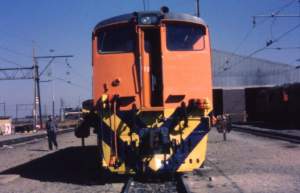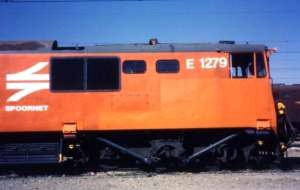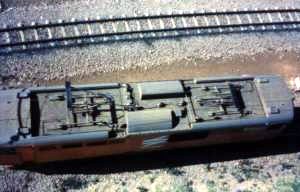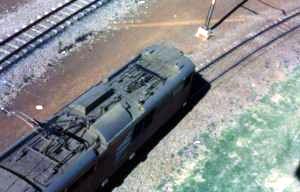







Similar
in drafts to it's predecessor class 5E, and of similar mechanical configuration,
the 6E is a superior machine, developing more speed and power for minimal
gain in size and weight, by improved power transfer to the rails. This
is effected by bellows between the frame and the wheels.
The latter
series, class 6E1, are recognizable by their large body-bogie torsion bars,
a further development of efficiencies in power transfer between body and
wheels.
Numbering
960 units, they are the most numerous locomotives on SPOORNET and the largest
class of electric locomotive in the world.
The class 6E is one of the most common locos still being used and seen today. A large number of the current class 6E1s are going to be converted to the new class 18E. There are, as far as I could establish already around 38 of the conversions done, with locos in daily service. (As at October 2002)
In December 1978, E1525 underwent experimental modifications for high speed running which included fitting a bullet nose and suitable gear ratio. With one coach in tow, the locomotive set the world narrow gauge speed record at 245 km/h (153 mph) over a distance of 3km between Midway and Westonaria near Johannesburg. The fiberglass nose is now displayed at the High speed Testing facility, Koedoespoort, Pretoria.
The 6E
series operates on 3000V DC. Some specs on the different models and
series are listed below. (Information is correct as far as I could
ascertain. However specs this is not the final word on loco details.)
|
|
|
|
|||||||
|
|
|
|
|
|
|
|
|
|
|
|
|
|
|
|
|
|
|
|
|
|
|
|
|
|
|
|
|
|
|
|
|
|
|
|
|
|
|
|
|
|
|
|
|
|
|
|
|
|
|
|
|
|
|
|
|
|
|
|
|
|
|
|
|
|
|
|
|
|
|
|
|
|
|
|
|
|
|
|
|
|
|
|
|
|
|
|
|
|
|
|
|
|
|
|
|
|
|
|
|
|
|
|
|
|
|
|
|
|
|
|
|
|
|
|
|
|
|
|
|
|
|
|
|
|
|
|
|
|
|
|
|
|
|
|
|
|
|
|
|
|
|
All pages
on this web site, including the complete page hierarchy and all photos,
copyright Francois Kritzinger, 2001, 2002, unless otherwise stated.
No images
may be used without permission